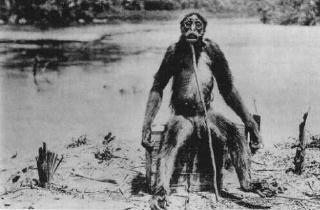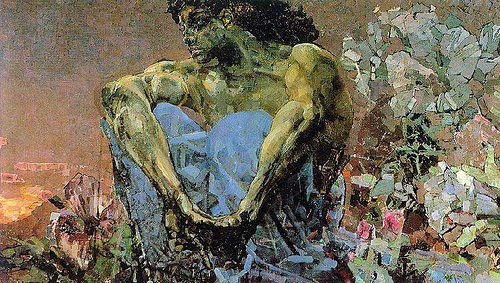Q: How many surrealists does it take to change a light bulb?
A: A vibrating Norwegian horse box full of sea cucumbers.
Q: How many surrealists does it take to change a light bulb?
A: A vibrating Norwegian horse box full of sea cucumbers.
The 10 oldest currently registered dot-com domains:

What is this? Is it a spider monkey? Or is it some unknown primate? We may never find out — this is the only photograph that survives from a strange encounter in the Venezuelan jungle in 1920.
Swiss oil geologist François De Loys was exploring near Lake Maracaibo when two creatures angrily approached his camp. The animals behaved like monkeys, holding onto shrubs and branches. The male escaped, but De Loys shot the female, which proved to be 1.57 meters tall, about half a meter larger than any known spider monkey. He said the creature had no tail, though it’s impossible to tell from the single photo he took.
All traces of the creature itself are lost — De Loys skinned it and kept the hide and skull, but he lost them during the difficult expedition (20 of the 24 explorers died).
Since then, authorities have argued endlessly about “Ameranthropoides loysi” — but it’s worth noting that that’s a regulation crate it’s sitting on, which supports De Loys’ contention about its size, and that its face, chest and hands differ in significant respects from a spider monkey’s. And there have been occasional reports of similar creatures in South America: “Mono Grande” may yet be discovered there.
Famous teetotalers:
Robert Benchley wrote, “Drinking makes such fools of people, and people are such fools to begin with, that it’s compounding a felony.”
“Of all the noises known to man, opera is the most expensive.” — Moliere

This is Malden Island, an uninhabited speck of land more than 1,500 miles from Hawaii. When Lord Byron’s cousin discovered it in 1825, he found a series of ruined stone temples in the interior, but the island was deserted. Who were the builders, where did they come from, and what became of them? No one knows for sure.
Proof that one dollar equals one cent:
$1 = 100¢
= (10¢)2
= ($0.10)2
= $0.01
= 1¢
In April 1977, as a joke, the British newspaper The Guardian published a seven-page supplement about a fictional island nation called San Serriffe. It fooled quite a few readers, which is surprising, since it’s essentially a series of bad puns about typography:
The island’s alternate name, if it needed any, is Hoaxe.

A classification of demons, from occultist Francis Barrett’s 1801 book The Magus:
More than 70,000 Australians declared themselves members of the Jedi in the 2001 census, thanks to a fad fueled by e-mail. So did 53,000 New Zealanders and 20,000 Canadians. In England and Wales, 390,000 people gave their religion as Jedi, making it the country’s fourth largest reported religion, behind Christianity, Islam, and Hinduism.
Ironically, the stunt led many otherwise apathetic people to take the census, so it may actually have improved its quality.